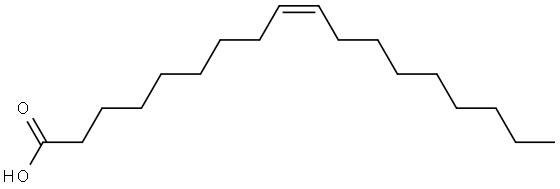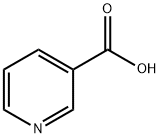Linoleic acid
Synonym(s):Linoleic acid;Linoleic Acid - CAS 60-33-3 - Calbiochem;Linolic Acid, cis,cis-9,12-Octadecadienoic Acid;Telfairic acid;cis,cis-9,12-Octadecadienoic Acid, Linolic Acid
- CAS NO.:60-33-3
- Empirical Formula: C18H32O2
- Molecular Weight: 280.45
- MDL number: MFCD00064241
- EINECS: 200-470-9
- SAFETY DATA SHEET (SDS)
- Update Date: 2025-12-26 08:49:36

What is Linoleic acid?
Description
Linoleic acid is an essential ω-6 polyunsaturated fatty acid (PUFA). It is the most abundant PUFA in a variety of foods, and dietary sources of linoleic acid include vegetable oils, meats, nuts, seeds, and eggs. Linoleic acid (30 μM) increases migration of IEC-6 rat intestinal epithelial cells in a wound healing assay. Rats fed a linoleate-deficient diet exhibit decreased body weight and an increased ratio of eicosatrienoate to arachidonate in liver and serum phospholipids compared with rats fed a control diet, as well as mild scaling of forepaw skin.
Chemical properties
Liquid at room temperature, colorless
Chemical properties
Linoleic acid occurs as a colorless to light-yellow-colored oil.
The Uses of Linoleic acid
linoleic acid (vitamin F) is also known as omega-6. An emulsifier, it is also cleansing, emollient, and skin conditioning. Some formulations incorporate it as a surfactant. Linoleic acid prevents dryness and roughness. A deficiency of linoleic acid in the skin is associated with symptoms similar to those characterizing eczema, psoriasis, and a generally poor skin condition. In numerous laboratory studies where a linoleic acid deficiency was induced, a topical application of linoleic acid in its free or esterified form quickly reversed this condition. In addition, there is some evidence in laboratory tests that linoleic acid may inhibit melanin production by decreasing tyrosinase activity and suppressing melanin polymer formation within melanosomes. Linoleic acid is an essential fatty acid found in a variety of plant oils, including soybean and sunflower.
The Uses of Linoleic acid
Linoleic acid(cis-9, cis-12-octadecadienoic acid), an essential fatty acid, can act as a radioprotective agent of BM while being toxic to certain tumor cells.
The Uses of Linoleic acid
Unsaturated μ-6 fatty acid Linoleic acid is involved in the production of quick-drying oils which are used in oil paints and varnishes. It is also used in beauty products due to its beneficial properties on the skin such as moisture retention. It is a key starting material for the synthesis of linoleyl alcohol and octadecanoic acid. It is used as a precursor of arachidonic acid (AA) and various prostaglandins. It may be used to improve the delivery and efficacy of anti-cancer drugs and in cancer protection.
What are the applications of Application
Linoleic Acid is a fatty acid with cytotoxic activity that influences the inflammatory process
What are the applications of Application
Linoleic Acid, water soluble is a complex of linoleic acid and methyl-β-cyclodextrin
Definition
ChEBI: An octadecadienoic acid in which the two double bonds are at positions 9 and 12 and have Z (cis) stereochemistry.
Production Methods
Linoleic acid is obtained by extraction from various vegetable oils such as safflower oil.
Definition
An unsaturated carboxylic acid that occurs in LINSEED OIL and other plant oils. It is used in making paints and varnishes.
Definition
linoleic acid: A liquid polyunsaturatedfatty acid with two doublebonds, CH3(CH2)4CH:CHCH2-CH:CH(CH2)7COOH.Linoleic acid isabundant in plant fats and oils,e.g.linseed oil, groundnut oil,and soyabeanoil.It is an essential fatty acid.
General Description
Colorless to straw colored liquid. A polyunsaturated fatty acid essential to human diet.
Air & Water Reactions
Sensitive to air and light. . Oxidizes across carbon double bonds
Reactivity Profile
Linoleic acid reacts to neutralize bases. May react vigorously with oxidizing agents. May react exothermically with reducing agents to release hydrogen gas.
Fire Hazard
Flash point data for Linoleic acid are not available. Linoleic acid is probably combustible.
Pharmaceutical Applications
Linoleic acid is used in topical transdermal formulations, in oral formulations as an absorption enhancer, and in topical cosmetic formulations as an emulsifying agent, and in aqueous microemulsions.It is also used in parenteral emulsions for total parenteral nutrition and in nonprescription oral dietary supplements.
Biochem/physiol Actions
Linoleic acid increases cell proliferation and gene expression of PPARα and its target genes such as acyl-CoA oxidase in primary duck hepatocytes .
Safety
Linoleic acid is widely used in cosmetics and topical pharmaceutical formulations, and is generally regarded as a nontoxic material. On exposure to the eyes, skin, and mucous membranes, linoleic acid can cause mild irritation.
Metabolism
Not Available
Storage
Linoleic acid is sensitive to air, light, moisture, and heat. It should be stored in a tightly sealed container under an inert atmosphere and refrigerated.
Incompatibilities
Linoleic acid is incompatible with bases, strong oxidizing agents, and reducing agents.
Regulatory Status
GRAS listed. Approved for use in foods in Europe and the USA.
Properties of Linoleic acid
| Melting point: | -5 °C (lit.) |
| Boiling point: | 229-230 °C/16 mmHg (lit.) |
| Density | 0.902 g/mL at 25 °C (lit.) |
| refractive index | n |
| FEMA | 3380 | 9,12-OCTADECADIENOIC ACID (48%) AND 9,12,15-OCTADECATRIENOIC ACID (52%) |
| Flash point: | >230 °F |
| storage temp. | Store below +30°C. |
| solubility | NaOH: soluble1M |
| form | liquid |
| pka | 4.77(at 25℃) |
| color | Clear yellow |
| Odor | faint fatty |
| Water Solubility | INSOLUBLE |
| FreezingPoint | -5℃ |
| Sensitive | Air Sensitive |
| λmax | 270nm(H2O)(lit.) |
| Merck | 14,5505 |
| JECFA Number | 332 |
| BRN | 1727101 |
| Dielectric constant | 2.6(0℃) |
| Stability: | Stable, but air and light sensitive. Combustible. Incompatible with strong oxidizing agents. |
| CAS DataBase Reference | 60-33-3(CAS DataBase Reference) |
| NIST Chemistry Reference | 9,12-Octadecadienoic acid (Z,Z)-(60-33-3) |
| EPA Substance Registry System | Linoleic acid (60-33-3) |
Safety information for Linoleic acid
| Signal word | Danger |
| Pictogram(s) |
 Flame Flammables GHS02  Exclamation Mark Irritant GHS07 |
| GHS Hazard Statements |
H225:Flammable liquids H319:Serious eye damage/eye irritation |
| Precautionary Statement Codes |
P210:Keep away from heat/sparks/open flames/hot surfaces. — No smoking. P305+P351+P338:IF IN EYES: Rinse cautiously with water for several minutes. Remove contact lenses, if present and easy to do. Continuerinsing. P370+P378:In case of fire: Use … for extinction. P403+P235:Store in a well-ventilated place. Keep cool. |
Computed Descriptors for Linoleic acid
| InChIKey | OYHQOLUKZRVURQ-KQHSAVHASA-N |
Linoleic acid manufacturer
New Products
4,4-Difluoropiperidine hydrochloride tert-butyl 9-methoxy-3-azaspiro[5.5]undecane-3-carboxylate Indole Methyl Resin N-Isopropylurea N,N-Dicyclohexylcarbodiimide(DCC) MELDRUMS ACID 5-METHYLISOXAZOLE-4-CARBOXYLIC ACID Magnessium Bis glycinate Zinc ascorbate 1-bromo-2-butyne 2-acetamidophenol 9(10H)-anthracenone Erythrosin B, 4-Piperidinopiperidine 2-((4-morpholinophenylamino) (methylthio) methylene) malononitrile 2,4-dihydroxybenzaldehyde 3-(4-morpholinophenylamino)-5-amino-1H-pyrazole-4-carbonitrile Methyl 2-methylquinoline-6-carboxylate 2,6-dichloro-4-nitropyridine 4-Bromo-2-chlorobenzonitrile 2-(benzylamino)acetic acid hydrochloride 4-(tert-Butoxycarbonylamino)but- 2-ynoic acid 3,4-dihydro-2H-benzo[b][1,4]dioxepine 1-Phenyl-1-cycloprppanecarboxylicacidRelated products of tetrahydrofuran








You may like
-
 Linoleic acid CAS 60-33-3View Details
Linoleic acid CAS 60-33-3View Details
60-33-3 -
 Linoleic Acid (Free Acid) extrapure CAS 60-33-3View Details
Linoleic Acid (Free Acid) extrapure CAS 60-33-3View Details
60-33-3 -
 Linoleic acid, 58-74% CAS 60-33-3View Details
Linoleic acid, 58-74% CAS 60-33-3View Details
60-33-3 -
 Linoleic Acid CAS 60-33-3View Details
Linoleic Acid CAS 60-33-3View Details
60-33-3 -
 Linoleic acid 97% CAS 60-33-3View Details
Linoleic acid 97% CAS 60-33-3View Details
60-33-3 -
 Linoleic acid CAS 60-33-3View Details
Linoleic acid CAS 60-33-3View Details
60-33-3 -
 Linoleic AcidView Details
Linoleic AcidView Details
60-33-3 -
 Linoleic Acid , CAS NO: 60-33-3, Grade: IpView Details
Linoleic Acid , CAS NO: 60-33-3, Grade: IpView Details
60-33-3
